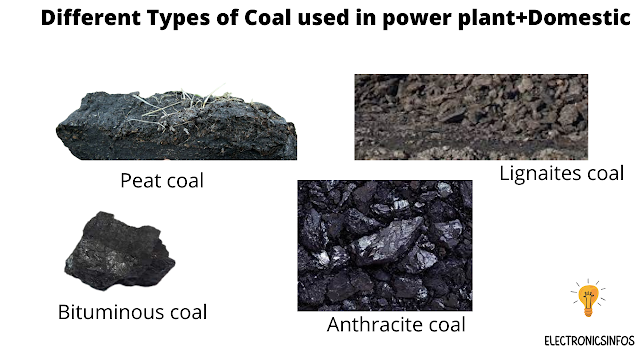What is Coal?

Coal is a fossil fuel that is mainly composed of carbon, along with other elements including hydrogen, sulfur, oxygen, and nitrogen. It is formed from the remains of plants and organic matter.
Coal is classified into different types based on its carbon content, moisture content, and energy content. 6 Types of solid coal fuels are used in power generation plants to produce Electricity.
Different coal have different efficiencies which depend on their internal properties.
Types of Coal
- Peat Coal
- Lignites Coal
- Bituminous Coal
- Anthracite Coal
- Wood Charcoal
- Coke
Peat Coal
peat coal is an initial state of coal. This is the raw state of coal if we want to use we need to dry the coal in sunlight. The calorific percentage in peat coal is 3500 kcal/kg. we used peat coal for domestic purposes because of the low value of the calorific.
Chemical Properties of Peat Coal
- Carbon Content: Rich in organic carbon (45% to 60%).
- Hydrogen Content: Contains hydrogen (5% to 7%).
- Moisture Content: High moisture content (75% to 80%).
- Ash Content: Contains inorganic minerals and ash.
- pH Level: Typically acidic (pH 3.5 to 5.5).
- Combustion Properties: Releases CO2, H2O, and gases when burned.
Lignites Coal
Lignite coal is the second form of coal in which the humidity level is 30-40% and its colour is brown. we cannot use lignites in power plants because the coal residual quantity is high. The calorific percentage in Lignite coal is 5000 kcal/kg.
Chemical Properties of Lignites Coal
- Carbon Content: Relatively low carbon content (25% to 35%).
- Moisture Content: High moisture content (20% to 40%).
- Energy Density: Lower energy density compared to higher-ranked coals.
- Colour: Brownish-black in colour.
- Texture: Soft and friable texture.
- Volatility: Highly volatile, releasing gases and volatile matter during combustion.
- Ash Content: Contains inorganic minerals and ash, with variable content.
- Combustion Properties: Combusts with lower energy output compared to higher-ranked coals.
Bituminous Coal
Bituminous coal is used as burning fuel. The calorific percentage in Bituminous coal is 7800 Kcal/kg. Bituminous Coal produces yellow gas including CO, CO₂, CH₄, H, N₂ and O₂.
Chemical Properties of Bituminous Coal
- Carbon Content: High carbon content (45% to 86%).
- Hydrogen Content: Contains hydrogen as part of its organic composition.
- Oxygen Content: Oxygen is present in organic compounds within the coal.
- Nitrogen and Sulfur Content: May contain varying amounts of nitrogen and sulfur.
- Moisture Content: Moderate moisture content (5% to 15%).
- Ash Content: Contains inorganic minerals and ash left after combustion.
- Volatility: Moderately volatile, releasing gases and volatile matter during combustion.
- Heating Value: High heating value (24 to 35 million BTUs per ton).
- Colour and Texture: Dark black colour with a compact, relatively hard texture.
Anthracite Coal
The Calorific percentage in Anthracite coal is 8500Kcal/kg. It burns with blue light. Anthracite coal is the last stage of coal and is mostly used in power plants to produce steam.
Chemical Properties of Anthracite Coal
- Carbon Content: Very high carbon content (over 86%).
- Hydrogen Content: Contains hydrogen as part of its organic composition.
- Oxygen Content: Present in organic compounds within the coal.
- Nitrogen and Sulfur Content: Generally low nitrogen content and very low sulfur content.
- Moisture Content: Very low moisture content (less than 15%).
- Ash Content: Contains inorganic minerals and ash left after combustion, with a low ash content.
- Volatility: Low volatility, releasing minimal gases and volatile matter during combustion.
- Heating Value: Highest heating value among coals (over 35 million BTUs per ton).
- Colour and Texture: Shiny black colour with a hard, glossy texture.
Wood Charcoal
wood coal is obtained when we slowly burn the wood. this is limited for domestic purposes because of the low value of the calorific percentage.
Chemical properties of wood CharCoal
- Carbon Content: High carbon content (usually above 75%).
- Hydrogen Content: Contains hydrogen as part of its organic composition.
- Oxygen Content: Lower oxygen content compared to wood, primarily in the form of organic compounds.
- Nitrogen and Sulfur Content: Generally low nitrogen and sulfur content.
- Moisture Content: Very low moisture content (usually less than 5%).
- Ash Content: Contains inorganic minerals and ash left after combustion, with a low ash content.
- Volatility: Low volatility, releasing minimal gases and volatile matter during combustion.
- Heating Value: High heating value due to its high carbon content.
- Colour and Texture: Black colour with a porous texture, resulting from the carbonization process.
Coke (Fuel)
when all types of gasses are extracted from coal this state is called coke. This type of coal is used in furnaces.
Chemical properties of coke
- High carbon content (above 90%).
- Low volatility.
- Porous structure.
- High density.
Properties of Coal
Some properties of good coal including- The calorific percentage must be high.
- The residual ash must be low.
- The sulphur percentage must be low.
- The external environment does not have much effect.
- we can also use it in powder form when needed which is called pulverized coal.
- coal must be Low-volatile which produces a stable flame.
- it must have a high BTU Value.
Advantages of Coal Fuel
- We can easily shift solid fuel.
- we can easily store it for a long time.
- solid fuel is naturally available.
- solid fuel has less effect on the environment.
- The cost is low.
Disadvantages of Coal Fuel
- We need a large space for storage purposes.
- The Environment is affected by pollution.
- Thermal efficiency is low.
- We need large labour.

-Electronicsinfos.png)



1 Comments
good
ReplyDeleteplease do not insert spam links